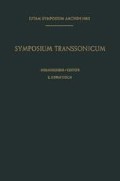Abstract
An aeroplane may be most susceptible to flutter in the transonic part of its speed range. Therefore, it is essential that theoretical flutter investigations can be carried out at Mach numbers in the vicinity of one. And for this purpose one must be able to calculate the aerodynamic forces which arise due to the flutter mode.
The author is indebted to S. Lidin for preparation of computer programs.
Access this chapter
Tax calculation will be finalised at checkout
Purchases are for personal use only
Preview
Unable to display preview. Download preview PDF.
References
Davies, D. E.: Three-dimensional sonic theory. Manual on aeroelasticity. Part II. Aerodynamic aspects. Chap. 4. AGARD, Paris, 1961.
Hadamard, J.: Lectures on Cauchy’s problem in linear partial differential equations. New York: Dover Publications Inc. 1952.
de Jager, E. M.: Nat. Aer. Res. Inst, of the Netherlands (NLL), Report MP. 192 (1960).
Jordan, P. F.: A R C, R & M No. 2932 (1957).
Landahl, M. T., and V. J. E. Stark: Roy. Inst, of Tech. Sweden, KTH AERO TN 34 (1953).
Landahl, M. T.: The Aer. Res. Inst, of Sweden (FFA), Report 80 (1958).
Landahl, M. T.: The Aer. Res. Inst, of Sweden (FFA), Report 81 (1959).
Miles, J. W.: J. Math. Phys., 33 135–143, No. 2 (1954).
Multhopp, H.:ARC R & M No. 2884 (1955).
Runyan, H. L., and D. S. Woolston: NACA Report 1322 (1957).
Stark, V. J. E.: SAAB Aircraft Company, Technical Note No. 41 (1958).
Stark, V. J. E.: SAAB Aircraft Company, Technical Note No. 44 (1960).
Author information
Authors and Affiliations
Editor information
Rights and permissions
Copyright information
© 1964 Springer-Verlag OHG., Berlin/Göttingen/Heidelberg
About this paper
Cite this paper
Stark, V.J.E. (1964). Applications at M = 1 of a method for solving the subsonic problem of the oscillating finite wing with the aid of high-speed digital computers. In: Oswatitsch, K. (eds) Symposium Transsonicum. International Union of Theoretical and Applied Mechanics (IUTAM) / Internationale Union für Theoretische und Angewandte Mechanik (IUTAM). Springer, Berlin, Heidelberg. https://doi.org/10.1007/978-3-642-88337-8_28
Download citation
DOI: https://doi.org/10.1007/978-3-642-88337-8_28
Publisher Name: Springer, Berlin, Heidelberg
Print ISBN: 978-3-642-48450-6
Online ISBN: 978-3-642-88337-8
eBook Packages: Springer Book Archive

